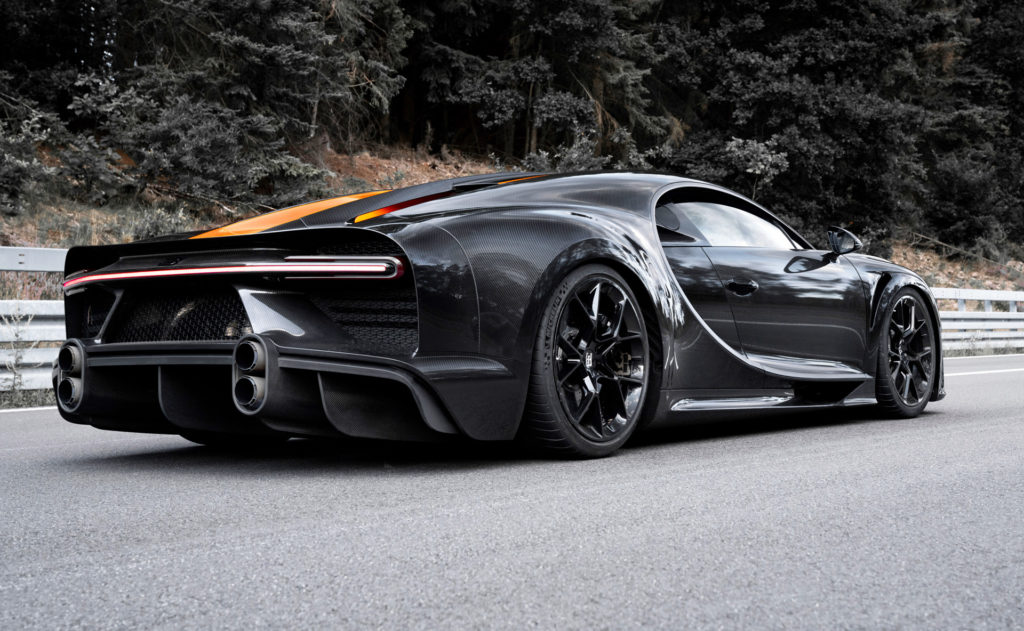

3D printing has proven itself time and time again as a leading technology for making short runs of specialty components, hence its widespread use in aerospace. Mirroring developments in the aerospace sector is the use of additive manufacturing (AM) in luxury and autosports vehicles. Bugatti has deployed the technology once again to 3D print titanium tailpipe trim covers for the Chiron Pur Sport and Chiron Super Sport 300+.
The trim cover measures a substantial 22 cm long by 48 cm wide and 13 cm tall while weighing only 1.85 kg, including the grill and bracket. By 3D printing the component using laser powder bed fusion, Bugatti was able to reduce the weight of the part by 1.2 kg. Design optimization included a lattice structure and filigree struts. At its thinnest points, the wall thickness of the part is just 0.4 mm, where only a single layer of printed powder was used.
The part can withstand temperatures past 650 degrees Celsius through the use of an outer wall that provides a double layer of thermal insulation. The part thus protects the components around it from the heat dissipating from the engine while the part itself is cooled from ambient fresh air.
Bugatti first publicly began experimenting with AM for end parts in 2018. It first 3D printed a titanium brake caliper, the largest 3D printed titanium part yet made. The company then began 3D printing the part in aluminum, making it 40 percent lighter than the traditionally made version, while still maintaining an operating temperature of up to nearly 1,100 degrees Celsius. Reportedly the firm had been making interior parts and dashboards for the Veyron before that, but this was never confirmed.
Bugatti has been using AM to produce the trim cover for its Chiron Sport and Divo since 2018, using the nickel-chrome alloy Inconel 718. Weighing 800 grams less than traditional covers at 2.2 kg, the 2018 trim covers shroud four tailpipes in order to minimize heat accumulation from the exhaust system.

For the 2018 trim covers, Bugatti relied on computer tomography to inspect parts for defects upon printing. Optical inspection is used for the new tailpipe covers, which are thin enough that air inclusions can be detected externally.
To finish the 3D printed tailpipe covers for the Chiron Pur Sport and Chiron Super Sport 300+, the part is blasted with corundum before a high-temperature black ceramic paint. This allows the component to maintain a matte finish while also providing greater protection.
As mentioned, this is just the latest in a now widespread use of AM in luxury and autosports production. A slew of racecar producers, from McLaren to Ferrari, now use the technology for everything from producing jigs, fixtures and prototypes to 3D printing end parts. Supercar makers including Lambourghini are also using AM for end parts, in addition to prototyping and manufacturing aids.
Part of what separates this most recent announcement from previous work is that the exhaust covers for the Chiron Pur Sport are the first 3D printed metal parts approved for road use that are visible to onlookers. The odds that any of us might see them outside of a trade show, however, probably aren’t high. The Chiron Pur Sport has a price tag of about $3.5 million, while the Super Sport 300+ costs nearly $4 million.
We’ve recently learned that the obvious talent leveraged to create these high-performance parts can at any time be redirected toward more crucial endeavors. ŠKODA, a Czech subsidiary of Volkswagen Group, is currently using its ingenuity to 3D print respirator masks to face COVID-19 medical supply crises in the Czech Republic. Because we are likely entering an era of unprecedented supply chain disruptions that are resulting from the unfolding climate crisis, including further epidemics, it may be necessary for businesses involved in less essential industries to redirect their efforts toward more imperative goods.
In the present, that means medical supplies like respirators, face shields, nasal swabs and ventilators. In the future, it may mean emergency responses to infrastructure collapses as a result of extreme weather events or even widespread production of renewable energy systems.
If you're looking to get architectural 3D animation in the USA, our service provides an exceptional way to bring your architectural concepts to life through dynamic, immersive visuals. Through our platform, you can easily request high-quality 3D animations that showcase your designs in motion, offering a detailed view of your project from multiple angles and perspectives. Whether it's for a real estate development, a commercial building, or an urban planning project, our expert team ensures that every detail is captured in a visually compelling animation.
Through our website, you can seamlessly get architectural 3D animation tailored to your project’s specific needs. With our help, you can offer potential clients or investors an engaging experience that goes beyond static images. By integrating CGI animations with real-world settings, lighting, and textures, our team creates a lifelike experience that allows your audience to interact with your project as though it were already built. This service is perfect for presenting complex designs in a clear, visually attractive way that stands out in the competitive architectural market.




